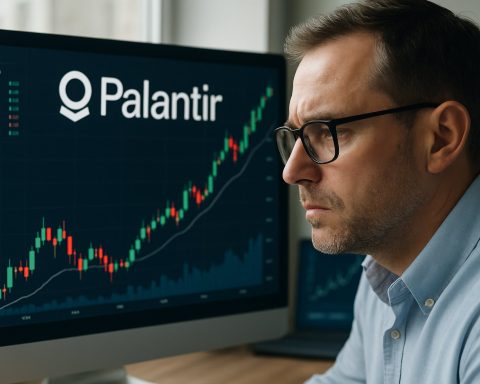- Palantir shares dropped by 32%, driven by unclear prospects amid defense budget cuts and other uncertainties.
- The company’s growth was initially fueled by market optimism and political influences, particularly with connections to the Trump administration.
- Despite challenges, Palantir’s core strength in AI and data analytics drives revenue growth, with U.S. commercial revenue increasing by 64% last quarter.
- Stock-based compensation is a concern, impacting shareholder value and profit potential.
- With a P/E ratio of 147, Palantir’s valuation is high compared to established companies, posing investment risks.
- Palantir’s future is a mix of high potential in AI innovation and commercial expansion, but operational and valuation challenges remain.
Shares of Palantir Technologies have taken a dizzying dive, shedding 32% from a recent peak. For investors who placed bets on the data analytics firm as a beacon of the artificial intelligence revolution, the recent tumult offers a moment of pause. What led to this upheaval, and what lies ahead for this tech heavyweight?
Palantir’s recent ascent was meteoric, fueled by a confluence of market optimism and political developments. The U.S. election, resulting in Donald Trump’s presidency, served as a key catalyst. Co-founder Peter Thiel’s connections to the administration stoked speculation about potential windfalls from government contracts. Yet, paradoxically, defense budget cutbacks proposed by the Pentagon threaten to curtail its most lucrative avenues. Palantir, a linchpin in military-grade data solutions, faces an unpredictable landscape as governmental purse strings tighten.
Despite the undercurrents of uncertainty, Palantir’s core operations offer a glimmer of hope. As a vanguard company wielding AI to revolutionize decision-making, it remains uniquely positioned to tap into growing commercial sectors. In the last quarter alone, revenue climbed an impressive 36%, driven by a 64% surge in U.S. commercial revenues. While these figures testify to the burgeoning appetite for AI-driven analytics, they also represent only a fraction of Palantir’s vast potential market.
Yet, the flipside reveals strains. The haunting specter of excessive stock-based compensation looms large, diluting shareholder value. Alarmingly, this compensation accounts for a significant slice of overall revenue, undermining the profit growth potential.
Wall Street’s skepticism is palpable. With a price-to-earnings (P/E) multiple of 147, the stock’s valuation eclipses more established market players, presenting a precarious investment. It’s a stark contrast to giants like Nvidia, which despite enjoying robust growth rates, boast far more modest valuations.
So, what’s the takeaway? Palantir’s pioneering strides in AI and commercial expansion offer promising pathways, yet its high valuation and operational challenges suggest investors tread cautiously. The journey ahead is fraught with both possibilities and pitfalls, and those eying Palantir should weigh these factors with a discerning lens.
Why Palantir’s Stock Could Swing Back: A Deeper Dive into Opportunities and Risks
Understanding Palantir’s Current Standing
Palantir Technologies has experienced a significant stock price drop, losing 32% from a recent high, raising concerns among investors about its future. Despite this downturn, the company remains a formidable force in leveraging AI for data analytics, fundamentally reshaping how organizations make decisions. Exploring key aspects of Palantir’s position reveals both opportunities and challenges that lie ahead.
Factors Behind the Stock Dip
1. Defense Contract Uncertainties: While Palantir’s connections to governmental contracts especially with the U.S. have been strong, proposed defense budget cutbacks could affect future revenue streams.
2. High Stock-Based Compensation: This remains a concern as it dilutes shareholder value and affects profit margins. In 2022, it accounted for a sizable portion of Palantir’s expenses, highlighting an ongoing issue that needs addressing.
3. High Valuation: With a P/E multiple of 147, Palantir is priced much higher than more established peers, making Wall Street wary. This valuation, though reflective of growth potential, is risky given market volatility.
Opportunities for Growth
1. Expansion in Commercial Markets: Palantir’s commercial revenue surged by 64% in the last quarter, indicating a strong growth trajectory in sectors beyond government contracts. Industries such as healthcare, energy, and manufacturing are increasingly integrating AI, presenting vast potential.
2. AI’s Pervasive Growth: The demand for advanced data analytics is expanding globally, positioning Palantir well, given its capabilities. This trend aligns with broader tech industry shifts towards AI-driven solutions.
3. Innovative Solutions: Palantir’s Foundry and Gotham platforms continue to receive updates and improvements, enhancing their appeal to sectors looking for robust, scalable data solutions.
Market Forecasts & Industry Trends
– AI Market Growth: According to Grand View Research, the global artificial intelligence market size was valued at USD 62.35 billion in 2020 and is expected to expand at a compound annual growth rate (CAGR) of 40.2% from 2021 to 2028. Palantir is well-positioned to capitalize on this growth trajectory.
– Diversification: Palantir’s shift from primarily governmental work to commercial applications signifies strategic diversification—a crucial move to mitigate risks tied to public sector spending fluctuations.
Actionable Investment Tips
1. Risk Assessment: Investors should evaluate their risk tolerance, considering Palantir’s high valuation and fluctuating defense revenues against its commercial and AI growth potential.
2. Stay Informed: Keep abreast of new government contracts, commercial partnerships, and product innovation announcements as indicators of financial health and direction.
3. Focus on Fundamentals: While assessing growth prospects is crucial, understanding the company’s financials, including its compensation practices and earnings, will guide informed decision-making.
Conclusion: Should You Bet on Palantir?
Whether Palantir rebounds or faces ongoing challenges depends on its ability to manage costs, grow its commercial footprint, and navigate a complex valuation landscape. Balancing optimism with caution is key for prospective investors.
For continued updates about the company’s future and comprehensive financial analysis, visit Palantir Technologies’ official website.
Palantir is navigating substantial transformation within a burgeoning industry—only time will tell if its strategic positions pay off.













